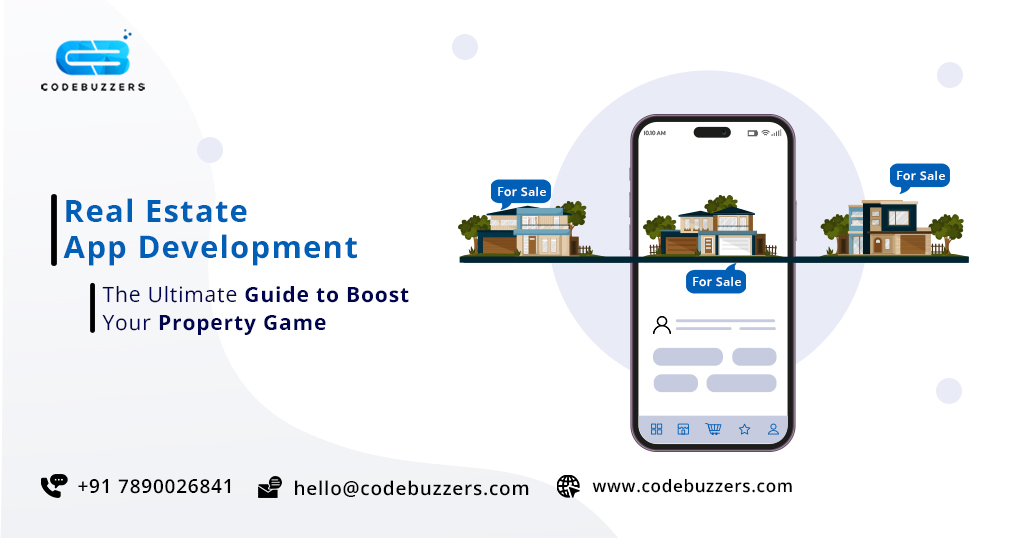The Ultimate Real Estate App Development Guide: Boost Your Property Game
The real estate industry has witnessed a significant transformation in recent years, thanks to the rapid advancement of technology. With the increasing reliance on digital platforms and mobile devices, real estate professionals and consumers alike have turned to real estate apps to streamline processes and enhance their overall experience. In today’s competitive market, having a well-designed and functional real estate app has become imperative for success.
The purpose of this blog post is to provide a comprehensive guide for developing a successful real estate app. Whether you are a real estate agent, a property developer, or an entrepreneur looking to venture into the real estate tech space, this guide will walk you through the essential steps and considerations for creating a powerful real estate app. From understanding the industry landscape and user preferences to designing a seamless user experience and implementing robust backend functionalities, this guide will equip you with the knowledge and insights needed to embark on your real estate app development journey.
Join us as we delve into the intricacies of real estate app development and unlock the potential of this rapidly growing industry.
Understanding the Real Estate App Landscape
Before embarking on the real estate app development journey, it is crucial to understand the real estate app landscape comprehensively. This section will explore existing real estate apps, analyze market trends and user preferences, and identify opportunities and challenges in the real estate app development market.
Exploring the existing real estate apps and their features:
Exploring the wide range of existing real estate apps is essential. Please examine these apps’ features, functionalities, and user interfaces. Pay attention to how these apps handle crucial aspects such as property listings, user registration and authentication, search filters, map integration, notifications, and other key elements. By studying successful real estate apps, you can gain valuable insights into effective strategies and identify potential areas for improvement and innovation in your app.
Analysis of market trends and user preferences in real estate app usage:
Understanding market trends and user preferences is paramount for developing a successful real estate app. Conduct thorough market research to identify the target audience for your app and gain insights into their specific needs and expectations. Analyze data and trends related to real estate app usage, such as the most sought-after features, preferred property types, popular search criteria, and user interaction patterns. This Analysis will help you align your app’s functionalities and offerings with the preferences of your target users, providing them with a more tailored and satisfying experience.
Identifying opportunities and challenges in the real estate app development market:
In addition to exploring existing apps and understanding user preferences, it is important to identify the opportunities and challenges in the real estate app development market. Assess the competitive landscape and evaluate the saturation level of real estate apps in your target market. Identify gaps or unmet needs that your app can address. Additionally, consider the technological, regulatory, and market-specific challenges that may arise during app development and deployment. By recognizing both the opportunities and challenges, you can strategize and position your real estate app for success in a competitive market.
By thoroughly understanding the real estate app landscape, exploring existing apps, analyzing market trends, and identifying opportunities and challenges, you will lay a solid foundation for the subsequent stages of real estate app development.
Pre Real Estate App Development Planning
Pre-development planning is a critical phase in the real estate app development process. This stage sets the foundation for a successful app by defining goals, conducting market research, and creating a comprehensive app development roadmap.
Defining the goals and objectives of the real estate app:
To begin, it is essential to clearly define the goals and objectives of your real estate app. Determine the purpose of your app and the problems it aims to solve. Are you creating an app for property search and management or connecting buyers and sellers? Establish specific goals, such as increasing user engagement, generating leads, or providing valuable market insights. Defining these goals will guide the entire development process and ensure that your app is aligned with your vision.
Conducting market research to identify target audience and competition:
Market research is crucial in identifying your target audience and understanding the competitive landscape. Analyze your potential users and their demographics, preferences, and pain points. Identify their needs and expectations from a real estate app. Research the competition to assess their strengths, weaknesses, and unique selling points. This knowledge will help you differentiate your app and tailor it to meet the specific needs of your target audience.
Creating a comprehensive app development roadmap, including timelines and budgeting:
Once you have defined your goals and conducted market research, creating a comprehensive app development roadmap is time. This roadmap should outline the various stages of development, including design, development, testing, and deployment. Set realistic timelines for each stage, considering the features’ complexity and available resources. Additionally, create a budget encompassing all app development aspects, including design, development, marketing, and ongoing maintenance. A well-defined roadmap and budget will provide a clear direction for your development team and ensure the smooth execution of your real estate app project.
By engaging in pre-development planning, including defining goals and objectives, conducting market research, and creating a comprehensive app development roadmap, you will lay a solid foundation for the subsequent real estate app development stages. This planning phase is essential for ensuring your app is strategically aligned, targeted toward the right audience, and executed within the allocated resources and timelines.
Key Features of a Real Estate App
When developing a real estate app, incorporating the right set of features is crucial for providing a seamless user experience and meeting the needs of your target audience. This section will highlight the key features to consider while developing a real estate app.
User registration and authentication:
Enable users to create accounts and authenticate themselves securely within the app. Implement email verification, social media login integration, or phone number authentication to ensure a smooth registration process. User registration and authentication are essential for personalized experiences, saved searches, and accessing premium features.
Property listings with advanced search filters:
Include a comprehensive database of property listings, allowing users to search for properties based on various criteria such as location, price range, property type, amenities, and more. Advanced search filters enhance user experience by providing tailored search results and helping users find their desired properties quickly.
Interactive maps and geolocation services:
Integrate interactive maps and geolocation services into your app to help users visualize property locations accurately. Display properties on a map, enable users to explore neighborhoods and provide driving directions. Geolocation services enhance the user experience and allow more precise property searches based on location.
Property details, including images, descriptions, and amenities:
Present detailed property information, including high-quality images, comprehensive descriptions, and amenities. Provide information on the property size, number of rooms, floor plans, and additional features. Clear and appealing property details help users make informed decisions and generate interest in the properties showcased on the app.
Saved searches and favorites list functionality:
Enable users to save their search criteria and create a favorites list within the app. This feature allows users to revisit their preferred properties, track property availability or price changes, and easily compare different listings. Saved searches and favorites list functionality enhance user engagement and simplify the property search process.
Real-time notifications and alerts:
Implement real-time notifications and alerts to inform users about new listings, price changes, property status updates, or other relevant information. Push notifications or in-app alerts ensure that users stay up-to-date with their saved searches and favorite properties, providing a timely and personalized experience.
Mortgage Calculator and financial tools:
Incorporate a mortgage calculator and financial tools to help users estimate their monthly mortgage payments, evaluate affordability, and explore financing options. These tools assist users in making informed financial decisions and contribute to a comprehensive real estate experience within the app.
Integration with third-party services like MLS and payment gateways:
Integrate with Multiple Listing Service (MLS) databases and other real estate data sources to provide up-to-date and accurate property information. Additionally, incorporate secure payment gateways to facilitate property transactions within the app, offering a seamless and convenient process for buyers and sellers.
By incorporating these key features, you can create a robust and user-friendly real estate app that caters to the needs of your target audience. Each feature enhances the user experience and provides valuable functionalities, making the app a go-to platform for property searches and transactions.
Real Estate App Development Process
The real estate app development process involves several stages that contribute to creating a robust and user-friendly application. This section will outline the key steps involved in the development process.
Choosing the right technology stack for real estate app development:
Selecting the appropriate technology stack is crucial for successfully developing a real estate app. Consider scalability, performance, security, and compatibility factors when choosing programming languages, frameworks, libraries, and databases. The technology stack should align with the app’s requirements and support its desired features and functionalities.
Backend development, including database management and APIs integration:
Backend development involves building the server-side infrastructure of the app. Develop a robust backend architecture that handles user management, property data storage, search functionality, and integration with external APIs (e.g., MLS, payment gateways). Efficient database management ensures data integrity and allows for seamless retrieval and manipulation of property information.
Frontend development for creating an engaging user interface:
Frontend development focuses on creating an engaging and user-friendly interface for the app. Design the user interface (UI) elements, layouts, and screens using frontend technologies such as HTML, CSS, and JavaScript frameworks. Implement intuitive navigation, smooth transitions, and visually appealing components to enhance the user experience.
Implementing robust security measures to protect user data:
Security is paramount when developing a real estate app that handles sensitive user data. Implement industry-standard security measures such as encryption, secure authentication protocols, and data validation techniques to protect user information from unauthorized access and data breaches. Regularly update and patch security vulnerabilities to ensure ongoing protection.
Testing and quality assurance to ensure app functionality and performance:
Thorough testing and quality assurance are essential to ensure that the app functions flawlessly and performs optimally. Conduct various types of testing, including functional, usability, performance, and security. Identify and address bugs, glitches, or usability issues to provide app users a smooth, error-free experience. Regular updates and maintenance are crucial to address emerging issues and incorporate user feedback.
By following a systematic and well-defined real estate app development process, which includes choosing the right technology stack, backend and frontend development, implementing robust security measures, and thorough testing and quality assurance, you can ensure the development of a high-quality app that meets user expectations and provides a seamless real estate experience.
App Launch and Deployment
Launching and deploying a real estate app requires careful planning and execution to ensure a successful introduction to the market. This section will outline key considerations and strategies for a smooth app launch and ongoing maintenance.
App store submission and compliance with platform guidelines:
Prepare your real estate app for submission to relevant app stores, such as the Apple App Store and Google Play Store. Familiarize yourself with the platform guidelines and requirements for submission. Ensure that your app meets all the necessary criteria, including design standards, content guidelines, and legal requirements. Thoroughly test the app to address potential issues that could lead to rejection. Following platform guidelines is crucial for a successful app store submission.
Marketing and promotional strategies for increasing app visibility:
Develop a comprehensive marketing and promotional strategy to increase the visibility of your real estate app. Leverage channels such as social media, online advertising, content marketing, and search engine optimization (SEO). Create engaging app descriptions, screenshots, and promotional materials highlighting your app’s unique features and benefits. Collaborate with industry influencers, real estate agents, and relevant publications to generate buzz and attract potential users.
Collecting user reviews and ratings for app improvement:
Encourage users to provide feedback, reviews, and ratings for your real estate app. Actively engage with users and respond to their comments and suggestions. User reviews and ratings provide valuable insights into the strengths and weaknesses of your app, helping you identify areas for improvement. Continuously gather user feedback and use it to guide future updates and enhancements to the app’s functionality, user experience, and overall performance.
Continuous monitoring and updates to address user feedback and industry changes:
Once your real estate app is launched, it is essential to continuously monitor its performance, user engagement, and industry trends. Implement analytics tools to gather data on user behavior, app usage, and conversion rates. Regularly review this data to identify opportunities for optimization and improvement. Stay informed about industry changes, technological advancements, and user preferences to ensure your app remains relevant and competitive. Continuously release updates and enhancements based on user feedback and market demands.
By carefully planning the app launch, complying with platform guidelines, implementing effective marketing strategies, collecting user reviews and ratings, and continuously monitoring and updating the app, you can maximize the visibility and success of your real estate app. Launching the app is just the beginning; ongoing maintenance and improvements are crucial for long-term success in the dynamic real estate market.
Monetization Strategies for Real Estate App Development
Monetizing your real estate app is essential for sustaining its development and generating revenue. This section will explore various monetization strategies that can be implemented to capitalize on the value of your app.
Subscription models and premium features:
Consider offering subscription plans or premium features within your real estate app. Provide users with additional benefits, such as advanced search filters, exclusive property listings, priority customer support, or access to market insights and trends. Offer different subscription tiers to cater to varying user needs and budgets. Subscriptions can provide a recurring revenue stream and incentivize users to upgrade for enhanced functionality and a more personalized experience.
In-app advertising and sponsored listings:
Integrate in-app advertising to generate revenue from your real estate app. Display relevant ads from real estate agencies, mortgage lenders, or home improvement services. Implement targeted advertising to ensure the ads are tailored to users’ preferences and do not disrupt the user experience. Additionally, consider offering sponsored listings where real estate agents or property developers can pay for increased visibility and prominence within the app.
Partnerships with real estate agents and brokers:
Forge partnerships with real estate agents and brokers to generate revenue through commissions or referral fees. Enable agents to showcase their properties within the app and facilitate lead generation and transactions. Establish mutually beneficial relationships by offering value-added services to agents, such as analytics and market insights, customer relationship management tools, or collaboration platforms. Building a network of trusted partners can contribute to the financial success of your real estate app.
Data monetization opportunities through analytics and insights:
Leverage the data collected through your real estate app to generate insights and analytics that can be monetized. Aggregate and anonymize user data to provide valuable market trends, property demand analysis, or neighborhood statistics to real estate professionals, developers, or investors. Consider offering premium data packages or reports that provide in-depth insights and enable data-driven decision-making. Ensure compliance with privacy regulations and maintain transparency with users regarding data usage and monetization.
Combining these monetization strategies allows you to generate revenue from your real estate app while providing value to users and industry stakeholders. It is important to balance generating revenue and maintaining a positive user experience, ensuring that the monetization methods are well-integrated and align with the app’s core value proposition. To maximize revenue potential, continuously assess and optimize your monetization strategies based on user feedback, market trends, and industry partnerships.
Future Trends in Real Estate App Development
The real estate industry continues to evolve with technological advancements, shaping the future of real estate app development. This section will explore key trends likely to impact the industry in the coming years.
Integration of emerging technologies like augmented reality (AR) and virtual reality (VR):
Augmented reality (AR) and virtual reality (VR) can revolutionize how users interact with real estate apps. By integrating AR and VR technologies, users can experience virtual property tours, visualize property layouts, and virtually decorate spaces. These immersive technologies offer a more engaging and realistic experience, enabling users to make informed decisions and explore properties remotely.
Artificial intelligence (AI) for personalized property recommendations:
Artificial intelligence (AI) can greatly enhance the user experience by providing personalized property recommendations. By analyzing user preferences, search history, and behaviour patterns, AI algorithms can suggest properties that align with users’ needs and preferences. AI can also automate processes such as lead generation, property valuation, and predictive analytics, streamlining operations for real estate professionals and users.
Blockchain technology for secure property transactions:
Blockchain technology has the potential to revolutionize the way property transactions are conducted by ensuring transparency, security, and immutability. Smart contracts on blockchain platforms can automate property transactions, eliminating the need for intermediaries and reducing costs. Blockchain can provide secure and verifiable property records, enable fractional ownership, and facilitate peer-to-peer transactions, making real estate transactions more efficient and trustworthy.
The impact of the Internet of Things (IoT) on smart home automation:
The Internet of Things (IoT) is transforming the concept of smart homes, and real estate apps can leverage this technology to enhance the user experience. Integration with IoT devices allows users to remotely control and monitor various aspects of their homes, such as temperature, lighting, security systems, and energy consumption. Real estate apps can offer features that enable users to manage and automate their smart homes, providing convenience, energy efficiency, and improved lifestyle experiences.
Real estate app developers can embrace these trends to create innovative and forward-thinking solutions by staying at the forefront of emerging technologies. Integrating AR and VR, AI-driven personalization, blockchain-enabled transactions, and IoT-powered smart home automation are anticipated to shape the future of real estate app development, revolutionizing the industry and delivering enhanced user experiences.
Conclusion
In conclusion, this blog post provided a comprehensive guide for developing a successful real estate app. We covered various key points throughout the discussion.
We began by understanding the real estate app landscape, exploring existing apps, analyzing market trends, and identifying opportunities and challenges. Pre-development planning was emphasized, including defining goals, conducting market research, and creating a development roadmap.
We delved into the essential features of a real estate app, such as user registration, advanced property search, interactive maps, property details, saved searches, real-time notifications, mortgage calculators, and integrations with third-party services.
The importance of user experience (UX) design considerations, such as intuitive interfaces, seamless navigation, visual elements, responsive design, and user feedback, was highlighted.
We explored the real estate app development process, including choosing the right technology stack, backend and frontend development, implementing security measures, and testing for functionality and performance.
Monetization strategies were discussed, including subscription models, in-app advertising, partnerships with real estate professionals, and data monetization through analytics and insights.
Lastly, we emphasized the importance of staying updated with industry trends and user expectations to ensure the success of a real estate app.
In conclusion, considering the key points discussed in this guide, we encourage you to start your real estate app development journey. Stay proactive in staying updated with industry trends and user expectations to deliver a cutting-edge and user-centric real estate app. Good luck with your real estate app development endeavor!
How Codebuzzers App Development Company Can Help Real Estate Businesses
Codebuzzers, as an app development company, can provide valuable assistance to real estate businesses in multiple ways.
Firstly, we can develop customized real estate apps tailored to the specific needs and goals of the business. The experienced developers can create feature-rich apps that facilitate property listings, advanced search functionalities, interactive maps, seamless user experience, and secure transaction processes.
We can also integrate emerging technologies such as augmented reality (AR) and virtual reality (VR) to enhance the app’s capabilities, allowing potential buyers to tour properties and experience them more immersive way virtually.
Additionally, we can implement data analytics tools within the app to provide valuable insights into user behavior, property trends, and market analysis. This information can help real estate businesses make informed decisions and strategize their marketing and sales efforts.
Furthermore, Codebuzzers offers ongoing support, maintenance, and updates to ensure the app remains up-to-date and aligned with industry standards.
In summary, Codebuzzers can assist real estate businesses by developing customized apps, integrating cutting-edge technologies, providing data analytics capabilities, and offering continuous support, ultimately helping businesses enhance their operations, improve user experiences, and drive growth in the competitive real estate market.



